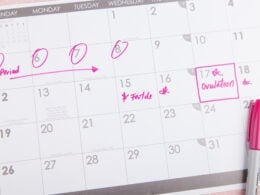“You need to make sure and record on the calendar each time you start,” my nana informed me after my first period in the 6th grade. It was right before my winter choir concert, and I couldn’t think of a worse time to begin my journey to womanhood. Did this really have to happen now? At that time, appreciating— let alone tracking— my fertility was the furthest thing from my mind.
“Okay,” I said, not understanding. I didn’t actually follow this advice until a few years later, but in the meantime she recorded it for me on a paper calendar, with little red dots irregularly punctuating each month.
“Middle-school periods” meant misery
Those dots came to represent the awful days on which nothing good could ever happen, according to the thinking of 12-year-old me. They held cramping, nausea, embarrassment, and sitting out on days in the pool—and there was no way for me to know when it was going to happen. Even if the red-speckled calendar and outdated videos from biology class would lead me to believe I would get my period again every 28 days, in reality it would never actually follow any sort of schedule. I didn’t realize until much later that it is quite normal for cycles to be highly irregular in the first years after puberty, as many first cycles are anovulatory, meaning they lack regular ovulation.
Years passed, and my resentment of these days grew. My cycles had finally begun to even out, but my symptoms had worsened. I had figured out how to swim and exercise on period days, but I still dealt with the emotional and physical rollercoaster of my cycle. When I mentioned these issues to my pediatrician during one of our final visits before I left for college, her answer was simple. “Oh, I can just write you a prescription for birth control for that.”
I declined her offer, as I didn’t feel like I had a need for the Pill. I had multiple friends who took birth control for either their acne or as contraception, and all of them complained about how it made them feel. The weight gain, bloating, headaches, and myriad of other long term effects just didn’t sit well with me. Still, the days of coming to appreciate my fertility were a long way off.
When I stopped believing my fertility was a burden
When I thought about the hormonal cycling I was going through every month, one word kept coming to my mind: burden. It felt like a burden to be at the mercy of my biology as a woman, and it felt like a burden I alone had to carry.
These feelings continued as I started dating my now-husband during our college years. Even though he was always extremely supportive of whatever I was going through (including once running across campus in the pouring rain just to bring me some ice cream and painkillers on an especially bad period day), I still couldn’t shake the feeling that this was all so unfair.
As we looked towards marriage and started discussing our future, we knew from the guidance of our Catholic faith that birth control was not an option. This was perfectly fine with me, as it was around this time that I discovered Natural Womanhood and began reading more about Fertility Awareness. I learned all about the different methods of learning how to read your fertility, and bought a basal thermometer and began to chart both my waking temperature, also known as basal body temperature, and cervical mucus observations. Even though we were only just engaged, the simple act of charting my cycles and learning about my body was eye-opening for me.
Suddenly, I was able to know the exact day my period would start, as my luteal phase was always the same number of days post-ovulation. I could make plans around this, take Ibuprofen in advance of my period to combat the pain, and feel less anxious about what was going on. My period no longer seemed like a monthly punishment but instead a part of a greater cycle of hormonal changes with health benefits for my whole body.
Using fertility awareness for pregnancy avoidance, pregnancy achievement, and postpartum
Once we were married, all those months learning how to chart finally paid off. I had a great deal of confidence in the symptothermal method (discussed more here) we had learned together. We took an online class with the Couple to Couple League, so both my husband and I could read my charts. He made sure that he knew the method rules just as well as I did, and instead of just me bearing the weight of our family planning, we both took responsibility for our shared fertility.
That’s not to say that practicing a Fertility Awareness Method (FAM) made everything easy in our marriage. Because we knew going into marriage that we did not want to get pregnant right away, there were difficult decisions to make every single cycle. Even though all of the training we had on FAM told us that it would only bring us closer as a couple, sometimes it seemed like it was doing the opposite. Avoiding pregnancy means avoiding sex during ovulation, which isn’t exactly easy as a newlywed. There were times when we both felt angry as—unlike any form of birth control—the reality of my fertility was still very much there. We couldn’t just pretend it didn’t exist, and sometimes that just added to the burden which I already had felt.
The difference, now, is that the burden is no longer just mine to bear. I not only have an understanding of my body and the innate beauty with which men and women were created, but I also am in a marriage which includes honest communication about my health in a way that would not be possible if I had just taken away the function of my fertility. My husband and I were a team from those newlywed days when we were learning how to practice FAM (and sometimes, frankly, not enjoying the process), through a difficult pregnancy and birth experience, and now as we navigate postpartum and parenthood together.
The beauty of fertility awareness beyond family planning
It’s difficult to continue to see the things your body is capable of doing as just a burden when you watch your eight-month-old crawl across the floor—which is exactly what I’m doing as I write this. In this new phase of life, I’ve had to begin to relearn everything I knew about charting and FAM. Breastfeeding kept my cycle away for a good long while, offering me time to reflect on the ideas I once had about Fertility Awareness.
While the realities of female biology can still be quite burdensome (and my period pain had nothing on my first trimester morning sickness!), opportunities for beauty and benefit also abound and I’ve truly come to appreciate my fertility as a gift. Not only can our female bodies create and sustain life—a pretty amazing feat notwithstanding—but there is so much more to our cycles than just painful periods. I’m just now learning about the myriad health benefits of charting beyond just family planning, and how important our cycles are as a health marker. Now that my fertility is returning, I am excited to learn about cycle syncing and working with my natural rhythms to pursue my postpartum health and wellness goals.
Most importantly, I look forward to the day when I can teach my daughter about the beauty she holds within her, and how her biology is more than just a burdensome few days a month. She deserves to understand and appreciate the way her body works, not simply to mask it with birth control from a young age. I’ll be able to teach her not only this, but also carry on the lesson from my Nana about why it’s important to record on the calendar each time you start your period—and a few other things, too.
Additional Reading:
4 ways free fertility awareness classes at my university improved my college experience
How do I know if a fertility awareness method will actually help me avoid pregnancy?
Yes, you can chart with a fertility awareness method while breastfeeding! How fertility awareness can help with severe menstrual cramps











